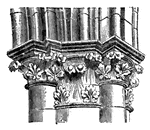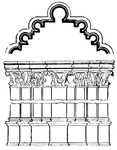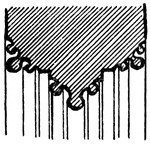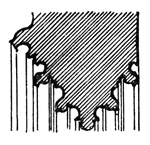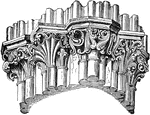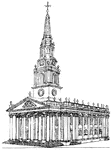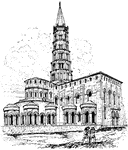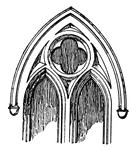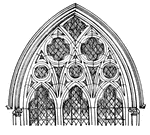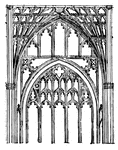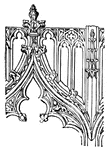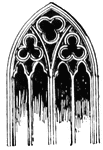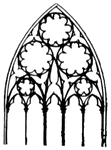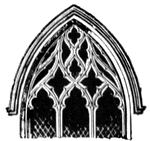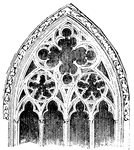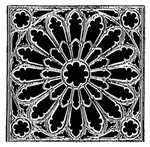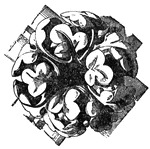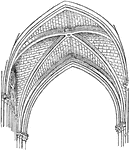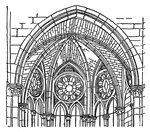This ClipArt gallery offers 254 examples of gothic architecture, from full churches and buildings to structural details. Gothic architecture is defined as the archiecture noted from the 12th to 16th century, originating in France. It superceded Romanesque architecture, and preceded the Renaissance. See also the Gothic Ornament ClipArt gallery.
Perpendicular Style
The third and last of the pointed or Gothic styles, also called the Florid style.
![This is a plan of the Cathedral at Tournai, Belgium. It is an example of Netherlands Gothic architecture. The construction lasted from 1146 to 1325. "In the 13th century [Belgium and Holland] came under the influence of the great Gothic movement in France, and two or three of their cathedrals compare [favorably] with the French cathedrals. The finest example of earlier date is that of the cathedral of Tournai, the nave of which was built in the second half of the 11th century, to which a transept with north and south apses and aisles round them was added about the middle of the 12th century. These latter features are contemporaneous with similar examples at Cologne, and the idea of the plan may have been taken from them; externally, however, they differ so widely that the design may be looked upon as an original conception, though the nave arcades, triforium storey, and clerestory resemble the contemporaneous work in Normandy. The original choir was pulled down in the 14h century, and a magnificent chevet of the French type erected in its place. The grouping of the towers which flank the transept, with the central lantern, the apses, and lofty choir is extremely fine."](https://etc.usf.edu/clipart/73400/73438/73438_tournal_mth.gif)
Plan of Cathedral at Tournai, 1146–1325
This is a plan of the Cathedral at Tournai, Belgium. It is an example of Netherlands Gothic architecture.…
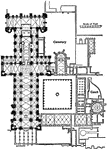
Plan of Durham Cathedral, 1093–1133
This is a plan of the Durham Cathedral, England. It is an example of English Gothic architecture. Building…
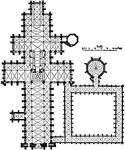
Plan of Salisbury Cathedral, 1075–1092
This is a plan of the Salisbury Cathedral, England. It is an example of English Gothic architecture.…

Plate Tracery, Charlton-on-Oxmore
With the growth in size of the windows and the progressive suppression of the lateral walls of vaulted…

Cathedral of Rheims
The Cathedral of Rheims is also known as Notre-Dame de Rheims in French. It is a Roman Catholic Cathedral,…
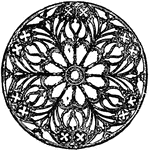
Rose Window
"A Rose Window is a circular window, divided into compartments by mullions and tracery radiating from…
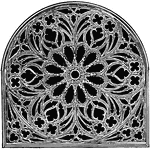
Rose Window, Church of St. Ouen, Rouen
A Rose window (or Catherine window) is often used as a generic term applied to a circular window, but…

Lantern Tower at St. Ouen; Rouen, France
In Gothic architecture, a lantern tower is frequently placed over the center of cross churches, and…

Plan of Sainte Chapelle, Paris
La Sainte-Chapelle (English: The Holy Chapel) is a Gothic chapel on the Île de la Cité…
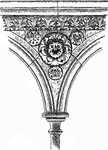
Sculptured Spandrel from Mont Saint-Michel
"...the triangular space comprehended between the outer curve or extrados of an arch, a horizontal line…
Spire from the Senlis Cathedral
Illustration of a spire of the Senlis Cathedral in France, early 13th century. It is "one of the earliest…
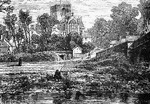
St. Asaph Cathedral
St Asaph Cathedral, (Welsh: Eglwys Gadeiriol Llanelwy) at St Asaph, Denbighshire, north Wales, is sometimes…
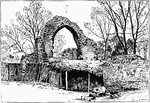
St. Pancras Church Ruins, Canterbury
St Pancras Old Church is a Church of England parish church on Pancras Road in North London. It is believed…

Plan of St. Sernin, Toulouse
"It was in Central France, and mainly along the Loire, that the systematic development of vaulted church…

Cathedral of Strasbourg
The cathedral of Strasbourg is a Roman Catholic cathedral located in Strasbourg, France. The church…
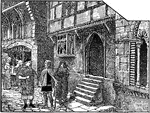
Gothic Street Corner
A reconstructed street corner scene of a house and store during the fourteenth century located in Perigueux…
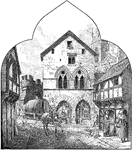
Fourteenth Century City Street
An illustration a typical street during the fourteenth century. The house in the back have Gothic tracery…
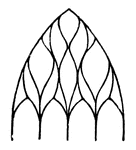
Tracery
Tracery is the intersection in various forms of the mullions in the head of a window or screen.

Tracery
Tracery is the intersection in various forms of the mullions in the head of a window or screen.
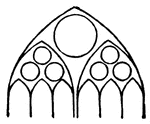
Tracery
Tracery is the intersection in various forms of the mullions in the head of a window or screen.

Tracery
Tracery is the intersection in various forms of the mullions in the head of a window or screen.

Tracery Foliations
The tracery on the windows of La Sainte-Chapelle, in Paris, France shows foliations: a leaf pattern…

Tracery of Rouen Cathedral
"Flamboyant Tracery, Rouen Cathedral, Normandy" showing the intersecting ribs of tracery in windows…

Gothic Architecture St. Margaret's Chapel Tracery
The window tracery from St. Margaret's Chapel, Herts from fourteenth century. The tracery is fitted…
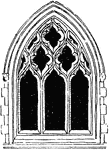
Large Gothic Window Tracery
A Gothic architectural window tracery commonly used during the fourteenth century. These windows were…
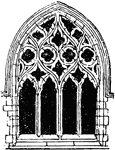
Small Gothic Window Tracery
A Gothic tracery window made of stone, and commonly found in Gothic architecture during the fourteenth…

Two Bays
Architecture of Cathredals in England. Two bays of Nave, interior at Winchester Cathedral, Perpendicular…
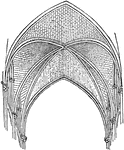
Sexpartite Vaulting
The Nave of Bourges Cathedral in France showing the sexpartite vaulting, divided into six parts.
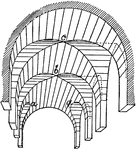
Vaults, Penetrations and Intersections
A: Penetrations by small semi-circular vaults sprung from same level. B: Intersection by small semicircular…

Venice Architecture
Examples of Gothic architecture in Venice, Italy: St. Mark's and the Doge's palace.
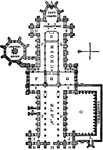
Wells Cathedral
"Plan of Wells Cathedral. A, Apse or apsis. B, Altar, altar-platform, and altar-steps. D E, Eastern…
